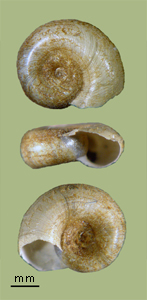> Habitat & Distribution
Gyraulus deflectus populations are widespread throughout Canada north to the central Arctic, south to Missouri, in quiet mesotrophic and eutrophic bodies of water, including wetlands, and shores of rivers, ponds, and lakes (Baker 1928, Clarke 1981, Jokinen 1992, Wu et al. 1997). The species is uncommon in our study area, however, being restricted to scattered lentic environments in the northern regions of Indiana and Pennsylvania, New Jersey and the Delmarva Peninsula. We have a single record in our Great Plains database, from a spring-fed creek in eastern North Dakota.
The literature also contains records of G. deflectus from the Washington, DC, area (Richards 1934, Steury 2014) and in North Carolina (Flowers & Grover 1993) we have not been unable to confirm. Gyraulus deflectus is peripheral in our 17-state eastern study area, FWGNA incidence rank I-3p.
Gyraulus deflectus populations have been reported to inhabit mud, sand, living vegetation, decomposing organic matter, and logs at depths of 0.3-9 m (Baker 1928, Harman 1972, Clarke 1981, Pip 1985, Jokinen 1992). In a survey of gastropods inhabiting the Precambrian Shield, Manitoba, Pip (1985) found G. deflectus populations in 56% of lakes greater than 10 ha in size, and 44% of rivers greater than 2 m deep, but never found it in ponds less than 10 ha and creeks less than 2 m deep. At New York and Connecticut sites inhabited by this species, pH ranged from 5.6-8.5, and calcium concentrations ranged from 1-89 ppm (Jokinen 1992).
> Ecology & Life History
Jokinen (1987) classified G. deflectus as a High-S species , characterized by low dispersal rates, good competitive ability, a tolerance for low resource (i.e., food) levels, and persistence at low population densities. Dillon s (2000: 360-363) reanalysis of these data suggested that G. deflectus populations in Connecticut seem to be Undifferentiated with respect to life history adaptation.
Egg capsules are small, gelatinous and often contain 2-5 eggs (Clarke 1981). A Connecticut population had a bivoltine life cycle, with eggs first appearing when water temperature exceeded 23 C in late June or July (Jokinen 1985, 1992). Hatchlings from that brood matured and produced a second batch of eggs from early September through early October, and these autumn-hatched young overwintered and produced eggs the following spring - life cycle type B(is) of Dillon (2000).
> Taxonomy & Systematics
The classification of the Planorbidae proposed by the tag team
of
Baker (1945) and Hubendick (1955) remains, after 50 years, the basis
for our understanding of this large and diverse family of pulmonates
worldwide. See the essay of 11Apr08 below.
The assignment of deflectus
to the worldwide genus Gyraulus
has remained stable. Gyraulus
hirsutus (Gould) is a synonym.
> Maps and Supplementary Resources
- Gyraulus distribution in the drainages of The Ohio (2019)
- Gyraulus deflectus distribution in Atlantic drainages (2023)
- Gyraulus distribution in The Great Plains (2024)
- Virginia species account with county distribution (2011)
> Essays
- See my post to the FWGNA blog of 11Apr08 for a review of the Classification of the Planorbidae.
- Or view the (Hubendick 1955) classification of North American planorbids in a tabular format [here].
> References
Baker, F. (1928) Freshwater
Mollusca of Wisconsin, Part I, Gastropoda. Bull. Wisc. Geol. Natur.
Hist. Survey, no. 70. University of Wisconsin Press, Madison.
Baker, F. (1945)
The Molluscan Family Planorbidae. Urbana: University of Illinois
Press.
Baker, H. B. (1946)
Index to F.C. Baker's "The Molluscan Family Planorbidae." Nautilus, 59,
127-41.
Burch, J.B. (1989)
North American Freshwater Snails. Malacological Publications, Hamburg,
Michigan.
Clarke, A.H. (1979) Gastropods as indicators of trophic
lake stages. Nautilus 93:138-142.
Clarke, A.H.
(1981)
The Freshwater Molluscs of Canada. National Museum of Natural Sciences,
National Museums of Canada, Ottawa, Canada.
Dillon, R.T., Jr. (2000)
The Ecology of Freshwater Molluscs. Cambridge University Press,
Cambridge, United Kingdom.
Flowers, J., & C.
Grover (1993)
New molluscan (Gastropoda and Bivalvia) records for the Neuse River
basin, North Carolina. Brimleyana 19:
61-64.
Harman, W.N. (1972)
Benthic substrates: their effect on fresh-water Mollusca. Ecology
53:271-277.
Hubendick, B.
(1955) Phylogeny in the Planorbidae.
Trans. Zool. Soc. London 28:
453-542.
Jokinen, E. H. (1985)
Comparative life history patterns within a littoral zone snail
community. Verh. Internat. Verein. Limnol. 22:
3292-99.
Jokinen, E.H. (1987)
Structure
of freshwater snail communities: species-area relationships and
incidence categories. American Malacological Bulletin
5:9-19.
Jokinen, E.H. (1992)
The
freshwater snails of New York State. New York State Museum Biological
Survey, New York State Museum Bulletin 482.
Pip, E. (1985)
The ecology of
freshwater gastropods on the southwestern edge of the Precambrian
Shield. Canadian Field Naturalist 99:76-85.
Richards, H. G. (1934)
A list of the mollusks of the District of Columbia and
vicinity. Amer. Midl. Natur. 15: 85 - 88.
Steury, B.W. (2014)
Aquatic snails (Gastropoda) from national park sites in Northern
Virginia and adjacent Maryland, with an updated checklist of regional
species. Banisteria 44: 13 - 18.
Stewart, T. W., &
R. T. Dillon, Jr. (2004)
Species composition and geographic distribution of Virginia's
freshwater gastropod fauna: A review using historical
records.
Am. Malac. Bull. 19: 79-91.
Wu, S.-K., Oesch, R.
& Gordon, M. (1997) Missouri Aquatic Snails.
Jefferson City: Missouri Department of Conservation.








